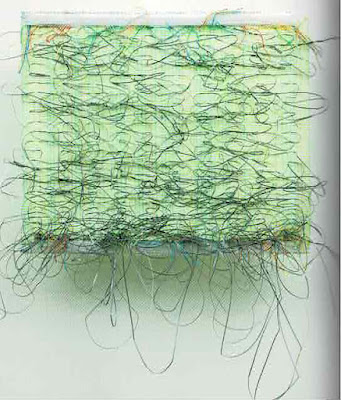Like you, perhaps, I get tons of information in my inbox about textile organizations, lectures, online workshops, and so on. It's a lot to take in sometimes, but sometimes--actually pretty often--I stumble upon pure gold. Recently someone linked to this blog post on the Textile Forum blog, about a body of work by Norwegian fiber artist, Solveig Aalberg.
Aalberg has made a series of 100 small pieces that she calls "miniatures" which together form the series Continuum. Each one measures about 20 x 24 cm, or roughly 7.75 x 9.5 inches. Each features horizontal stripes in some form. They are woven in tabby or double weave in a variety of fibers. As she wove the series, Aalberg designed a book that reproduces every single piece, Continuum: Woven Miniatures. The book devotes a full page, or in some cases two pages, to each tapestry, and for each, the fibers and colors used are listed with a numerical notation that indicates the number of times each color is repeated.
 |
| Solveig Aalberg, Continuum #020, 2018. Linen, cotton, polyester. |
As I began to look through the book, I realized that far from becoming repetitious the project allowed for almost infinite variation within Aalberg's parameters. The idea that boundaries and limits actually free us up for greater creativity has been coming up in my tapestry feedback group discussions lately, and Aalberg's project is a perfect example of how that can work.
Aalberg says in an interview included at the end of the book that her work is "all about reading the world around me by organizing structures and repetitions. Tapestry's strict framework of horizontal and vertical lines provides a basis for working on my visual idiom. It might seem restrictive, but it is a challenge that triggers me." (p. 260). She goes on to say that systems and mathematics allow for rhythmic repetitions would not be possible otherwise: ". . . structures build up contrasts and juxtapositions that you couldn't envision beforehand without using these systems." (p. 265).
While Aalberg's work starts with weaving on the loom, she further develops each piece by adding stitching, sometimes subtle straight stitches that meld with the weft, other times wild loops and dangling threads that create a riot of texture on the back. These pieces are pictured front and back on double-page spreads. In all the pieces, a delight and curiosity about color is the driving force.
 |
| Solveig Aalberg, Continuum #036 back, 2020. Linen, cotton, polyester and reflex. |
 |
| Solveig Aalberg, Continuum #036 front, 2020. Linen, cotton, polyester and reflex. |
Aalberg has worked on a very large scale many times, but for this project she chose a format that invites the viewer to "experience the work up close" in an "intimate and personal" way (p. 264). Many of us are attracted to small format work not only because it is portable and more quickly accomplished than large work, but precisely because it speaks one-on-one to the viewer.
Pieces from the Continuum series have been exhibited in various shows in Europe, and several have been sold. Aalberg hopes that the works will be widely disseminated and that they can "thereby make a little statement about how everyday life is influenced by how we do the same thing again and again, but with either minor or major changes. In that way, each miniature can be read as a metaphor for the days we live" (p. 267).
 |
| Solveig Aalberg, selections from Continuum at Haugesund Kunstforening og Billedgalleri, 2020. (Please excuse the book's center crease shadow through the near yellow piece.) |
Regarding her commitment to a long-term project over several years, Aalberg admits "It does cost something to bring this about--that is also part of the process. Showing tenacity, holding on to your idea, not letting go. If I had abandoned Continuum, it would be like going back on a promise. It would feel like a betrayal" (p. 267). This struck me--how often do we as artists lose heart, have crises of confidence, or simply bow to the ongoing pressures of life and abandon our big ideas?
Regarding the book itself, in addition to the interview with the artist, an essay by writer Ole Robert Sunde is included, whose work Aalberg feels draws on similar themes. All text, including captions for the tapestries, appears in Norwegian and English. Several installation shots of the work show how it is mounted approximately 4.5" from the wall, so that it casts a shadow and attains a sculptural presence. It is a beautifully photographed and produced hardcover book. You can order it here for 380 Norwegian kroner, about $38 plus shipping. For me this book is a wonderful counterpoint to Sheila Hicks's Weaving as Metaphor, which contains images of dozens of her experimental minimes. Both artists work in small format, but their approaches and results are very different. Food for thought.

No comments:
Post a Comment